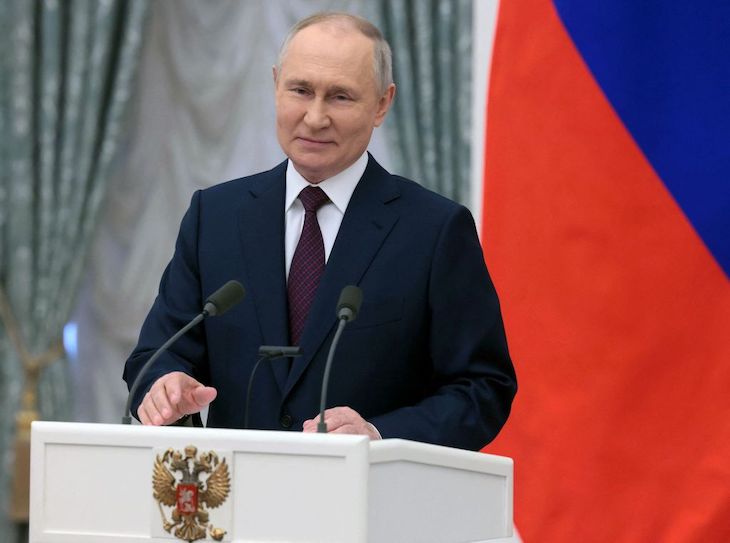Following Vladimir Putin’s invasion of Ukraine in February 2022 and the calamitous, early missteps of the Russian army, many Western experts fairly crowed over the possibility of Russia disintegrating. ‘It’s high time to prepare for Russia’s collapse,’ ran a typical headline on the Foreign Policy website, while a survey of 167 foreign-policy experts by the Atlantic Council think tank last January found that 40 per cent of them expected Russia to break up internally within ten years due to ‘revolution, civil war, political disintegration’ and so on. Meanwhile, an article from the Hudson Institute was more prescriptive, issuing a list of points to consider when ‘Preparing for the Final Collapse of the Soviet Union and the Dissolution of the Russian Federation’ – among them, ‘Contain any spillover from internal Russian fighting’ and ‘Maintain superior strength in Europe.’
Yet two years on, Russia looks in alarmingly robust condition, having mobilised its own military complex as well as receiving weapon-stocks from allies like Iran and North Korea. Nor do sanctions seem to be working: Russia’s industrial base – perhaps due to the war itself – is growing at the rate of 3.6 per cent and its manufacturing output at 7.5 per cent. If you aren’t mobilised, don’t live in the border regions of Russia – now regularly shelled by the Ukrainian forces – and are unused to travelling abroad (70 per cent of Russians, according to RIA Novosti) your life probably hasn’t changed much. Except for a few censorship laws threatening imprisonment for ‘discrediting the Russian army’, the country’s notably free of the usual restrictions of wartime – full-scale martial law, curfew, military patrols or rationed food. And despite a host of triumphalist articles in 2022 speaking about the ‘revival’ of the West and deriding Putin’s catastrophic ‘underestimation’ of his opponents, it increasingly seems it’s not the Russian Federation suffering disunity and fracture, but the West itself, whose countries have radically differing policies towards Ukraine.
If you aren’t mobilised and don’t live in the border regions of Russia your life probably hasn’t changed much
These countries split roughly into four categories. In group A, we have those which continue to give substantial aid to Ukraine, and whose support is unwavering: Germany, the UK, the Baltic States, Nordic countries, and the Netherlands. Germany, after a shaky start, has unveiled plans to double its aid to Kyiv in 2024, while the Netherlands and Denmark are providing Ukraine with US-made F-16 fighters, the first of which are expected to arrive in the next few weeks. Meanwhile the UK – despite Boris Johnson’s accusation the government were ‘dragging their feet’ – remains a key provider of all support, outflanked only by the US and Germany.
This isn’t to say an equal percentage of GDP is being contributed by these countries. According to estimates from the Kiel Institute of Economics, Germany had, at the end of October 2023, delivered since the beginning of the war €20.9 billion of aid (£18.1 billion), or 0.52 per cent of GDP, while the U.K. had sent €13.3 billion (£11.5 billion), or 0.45 per cent. To put these figures in context, Estonia, with its population of 1.3 million, had contributed a whopping 1.3 per cent.
Group B contains countries which also provide aid, including the military kind, though significantly smaller, and some of it tricky to quantify (it may come in the form of training or intelligence). This group contains France, Spain, Belgium and Italy, all of which contribute less than 0.1 per cent of GDP.
In Group C, we have countries which started off strongly but whose support is faltering or whose military aid has died out altogether, a group including Slovakia and Poland. Though Poland has contributed a staggering 0.67 per cent of GDP, the relationship between the two countries has been soured by Poland’s embargo on Ukrainian grain, as well as the ongoing blockade of border crossings, holding up key military volunteers, by Polish truckers. As to state-provided military aid, it’s simply not coming anymore: ‘We are no longer transferring weapons to Ukraine because we are now arming Poland with more modern weapons,’ the Polish PM said.
Slovakia is a further case in point. Although it started out a firm supporter of Ukraine, sending all the country’s 13 MIG-planes to its beleaguered neighbour, things changed abruptly with the return to power of Robert Fico in October 2023. Fico immediately declared that his government was going to halt all previous military aid, adding ‘We have nothing to do with this war’ – a sentiment subsequently affirmed by the Slovakian parliament.
Finally, in Group D, we have countries which either send less than 0.05 per cent of their GDP or nothing at all, including Hungary and Serbia. Indeed, the Hungarian government is actively opposing contributions to Ukraine’s war effort. Just recently Hungarian prime minister Viktor Orban warned he could ‘pull the handbrake’ on future financial aid, making good on this threat in December, when Hungary vetoed €50 billion (£43 billion) from the EU.
Serbia meanwhile has attempted a kind of balancing act. Due to historic links with Russia and a sense of Ukraine’s pro-American policy as a betrayal of European identity (the Nato bombing of Belgrade, though nearly a quarter century ago, is still raw in Serbian memories), there is plenty of support for the Kremlin in this conflict and nearly 80 per cent of Serbs oppose sanctions against it. However, as an EU candidate since 2012, outright alignment with the Kremlin is impossible, and when Serbian ammo was found to have reached the Ukrainian army through intermediaries earlier this year, president Aleksandar Vučić rejected any crackdown: ‘What is the alternative for us? Not to produce (ammunition)? Not to sell it?’.
Naturally, all these divisions pale beside those in the US, which has provided more military aid to Ukraine than all EU countries combined, but now seems paralysed by internal splits. Though $61 billion (£48 billion) was earmarked for Ukraine by the Biden administration, Republicans have blocked him, adding that further calls for aid to Kyiv will be resisted unless tied to greater funding for US border security. The outcome of this stand-off remains to be seen; congressional discussions are set to continue in the coming weeks.
In the meantime, throughout the West, confusion reigns. Whatever hymn sheets these countries are singing from, they come in a Babel of different languages and from a church so broad it risks having no unifying creed at all. Whether in this conflict it will continue to prove a genuine force for global security, rather than a riven conglomerate of countries once united by values they no longer share, is one of the major questions of the coming year. At the moment, the West’s faltering resolve, in the wake of the apparent resurgence of 2022, can be likened to the behaviour of a man who, following a cancer scare, immediately quits smoking – only to see, as memory of the threat recedes, his habit creep back up to previous, life-endangering levels.
As for Russia’s survival, it may be the most realistic assessment has come from Alexander Etkind, historian and professor at the Central European University in Vienna. Interviewed last month in Russia’s New Times, he was sanguine but realistic. The Russian Empire would eventually disintegrate as a result of the war in Ukraine, he said, though probably not any time soon: ‘We must try to live to see it.’
But given the current parlous state of the Western alliance, it’s anyone’s guess which will tumble first.
This article is free to read
To unlock more articles, subscribe to get 3 months of unlimited access for just $5







Comments
Join the debate for just £1 a month
Be part of the conversation with other Spectator readers by getting your first three months for £3.
UNLOCK ACCESS Just £1 a monthAlready a subscriber? Log in